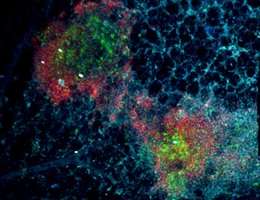The immune response to heart attacks

The damage caused by a heart attack triggers an inflammatory reaction which degrades the affected tissue. This response is orchestrated by immune cells that reside in the nearby pericardial adipose tissue, as a study by an LMU team shows.
Following a heart attack, the innate immune system must kick in fast in order to limit the damage and stimulate tissue repair. Researchers led by Sabine Steffens, Professor of Clinical Pathobiochemistry at the Institute for Cardiovascular Prevention (IPEK) at LMU, have now identified the sites at which the inflammatory response to myocardial infarction is regulated. Activation of the response occurs in clusters of immune cells (lymphocytes) within the fatty tissues of the so-called pericardium, which surrounds the heart. The findings appear in the journal Circulation.
"Lymphocyte clusters play an important role in orchestrating adaptive immune responses and monitoring inflammation processes," says Steffens. These clusters were first discovered at several sites in the adipose tissues of mice in 2015. "They are thought to act as infection or damage sensors, which can rapidly stimulate an immune response. The pericardial adipose tissue, which is situated adjacent to the heart muscle, is particularly rich in such lymphoid clusters and, as Steffens explains: "In the aftermath of an acute heart attack, these clusters are responsible for initiating and coordinating the ensuing immune response." Lymphocytes are activated and signaling molecules called cytokines are secreted, which recruit neutrophils (another type of immune cells) to the damaged area of the heart muscle. The neutrophils in turn induce an inflammation reaction that results in the degradation of the damaged tissues by phagocytes, and they subsequently help resolve the primary inflammation reaction and promote tissue repair.
In the new study, Steffens and her team have now elucidated how the lymphocyte clusters in the pericardial adipose tissue regulate the post-infarction immune response in a mouse model. The work also suggests that this process has a critical impact on the healing of the heart tissue. In addition, the team analyzed data from patients with and without coronary artery disease, which revealed that the former group had significantly higher numbers of lymphocytes in the pericardial adipose tissue than patients whose hearts were healthy. The results might also be relevant to the treatment of patients who have suffered acute heart attacks, as modulation of the pericardial immune response could have a positive impact on tissue repair.
More information: Michael Horckmans et al. Pericardial Adipose Tissue Regulates Granulopoiesis, Fibrosis and Cardiac Function After Myocardial Infarction, Circulation (2017). DOI: 10.1161/CIRCULATIONAHA.117.028833














